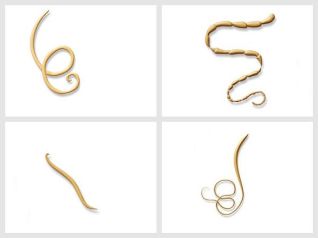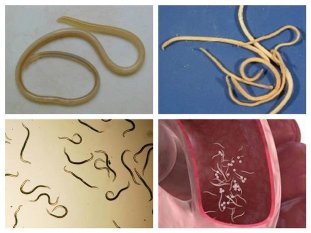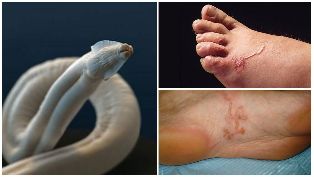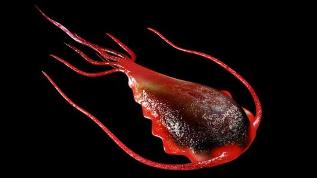Daily helminths infected adults and children, from this it can be argued, but not always. Therefore, in order to clearly understand what we have, that you have to know their type. Only is correct identification of the helminth, it is possible to win.
In this article, You will learn about: what human worms exist where you can pick up the typical signs of infestation. Take care of your health and remember that is a.

Human worms — classification
Helminths (worms) – a large class of worms, parasites that live in humans, animals and plants. Helminths, parasitic worms, feeding on the internal resources of the body "boss" not only weaken the body, but also contribute to the development of other diseases related to the.
Curiously, but almost every second person – the bearer of one of the types of worms and not even know it until complications occur or will be conducted an additional examination. In function of the climatic zones on different continents are different worms.
Also, worms are divided by the via transfer from the body to the body:
- bio worms transfer of animals;
- contagious – transmitted from an infected person;
- geo worms – larvae stored in the soil.
When ingested larvae ingested, they move through the body in the blood stream and deposited in the organs. Most often, the worms establish themselves in different parts of the intestine. Classification of the place of settlement of parasites:
- Translucent worms – live in hollow organs.
- Tissues found in the tissues.
- Others can live in the hollow organs, and in thicker fabrics.
In nature there are about 250 species of helminths. Each requires certain conditions for its existence and development. The worms differ in size, shape, and other characteristic features.
The classification of these parasites is not yet fully formed and validated by scientists.
Separation of worms on a territorial base, it is also the place to be. This fact complicates the classification of parasites. In the countries of middle latitudes with temperate climatic conditions is possible to have more than 20 species of helminths, which are divided into three groups depending on the appearance and form:
- Round (nematodes);
- The tape (cestodes);
- Flat (trematodes).
Nematodes and trematodes are more common in nature than the tape parasites. The human body is an ideal environment for the reproduction and growth pinworms and ascarids. Also common and Trichinella. In cestodes belong to the bovine, porcine, rat cepni, a had.
Types of worms in humans — worms (nematodes)
Another name for these worms – nematodes. This type of worms is considered to be the most common. It is characterized by a round body shape in cross-section. The length of the body and of the different species of worms can vary from 5 mm to 40 cm.

For life, they usually choose the small, but easy to migrate to the host body and can live in other organisms.
The wide distribution of nematodes is due to the fact that the infection with them is very easy. Intermediate host is not necessary, and that are transmitted from an infected to another. Also, the infestation can develop to eat unwashed fruits or vegetables. It is for this reason that the infection by these helminths is peculiar to children, as they tend to violate the rules of hygiene.
Pinworms
Pinworms – representatives roundworms have a round shape, with a length of about 2 inches. Occur in children and adults. Settle in the small intestine and develop from this stage to adult for 2 weeks. Pinworms cause the disease enterobiasis.
Enterobius infection is manifested by inflammation of the walls of the intestine, alters the digestion, and toxins worms cause local haemorrhages. The disease manifests itself in the evening itching in the anus. Itching because of the females for laying their eggs.
To be infected with Enterobius is possible not only through contact with common objects with an infected person, but also through the vegetables in the garden (eggs stored on the floor), cockroaches and flies can carry the eggs of worms. When enterobiasis in women parasites can cause inflammation of the genital organs. Also become inflamed and scratching, which leads to staph.
Roundworm
Ascarids – round worms grow up to 40 centimeters and with a diameter of about 6 inches. The eggs of ascarids in contact with the ground can be stored for a year before getting into a favourable environment for the development. When roundworm larva enters the host and begins to grow, it produces toxins that affect the lungs, the liver.
The larva travels throughout the body and affects the blood vessels and causes injury inflammatory. Settles in the intestine and feeds on its contents. A day can lay several thousands of eggs.
Due to its considerable size roundworm in search of food can move in the ducts of the pancreas, bile ducts and liver, cause inflammation of the intestine may reach the throat and block the airway. Cause diseases such as ascariasis.
The presence of ascarids in the body can be recognized by these symptoms:
- Nausea and vomiting, abdominal pain.
- The fatigue.
- Diarrhea, red worms in the stool.
- Allergic reactions.
Worms tend to curl into a ball, therefore there is an obstruction of the intestine, and as a result of peritonitis.
Whipworm
Following the representative of the round worms is the whipworm. Its length is 5 cm. Its peculiar shape, the main part is thin, and the short section of wide. The presence of human whipworm can cause trihozefalez.
The presence in the body of whipworm trichocephalosis door and is manifested by symptoms:
- abdominal pain, loss of appetite;
- diarrhea, constipation changes;
- sometimes the blood in the stool;
- iron-deficiency anemia.

Toxocara
This species of worms live in the stomach of dogs and feces the eggs fall to the ground. Externally, the parasite like a roundworm, but it grows only to 15 inches. The full life cycle of this parasite takes place in the body of the dog, in order to achieve a favorable environment for the human, the larvae perish, but have time to do evil.
Hit the muscles, the liver, the lungs, the heart, the tissues of the eye, the brain, the disease toxocariasis.
The activity of the larvae in the body is manifested by symptoms:
- increase of temperature;
- swelling of the lymph nodes and the liver;
- eruption on the skin;
- lung infiltrates;
- shortness of breath, wheezing, dry cough;
- mental disorders and seizures;
- a blood test shows the presence of eosinophils.
You can confirm the diagnosis by scraping the affected area of the skin, a blood test for antibodies, biopsy liver.
Ancylostoma
In this case, the infection occurs through the skin or if swallowed larvae. With the blood that may be in the lungs and the heart, but prefer the small intestine. They live about 4 years, making it the hookworm. Your symptoms:
- Fever.
- Increase of the salivation.
- Eosinophilia.
The pathology occur in the operation of the stage of infection, when the body accumulates a large amount of worms. The first stage can be asymptomatic, which detect the pathology could accidentally.
Tapeworms (cestodes)
If you examine all the varieties are found in humans, the worms, the tapeworms are among the most dangerous. The main risk associated with size, as this type of parasite can reach a length of 18 metres.
Because of this, their influence on the human body is very unfavorable. The full cycle of their life requires a change of owner. Some part of tapeworms live in the body of cattle, which are transferred to the people.
A had
A had reaches 10 meters in length. With cracks in the head, it is attached to the surface of the intestine. The human body gets from raw freshwater fish as a larva and develops fully within a month.
A symptom of the presence of the parasite in the body appears like the following:
- beriberi a deficiency of vitamin B12, folic acid;
- vomiting, nausea, diarrhea;
- disorders of the gastrointestinal tract;
- exhaustion;
- the increase of the temperature.
This parasite is nourished by absorption of nutrients to the surface of his considerable body. At the point of union wide had developed necrosis. In Calais appear segments (with eggs) of the worm and the eggs.

Beef had
Veal had (had) lives in the small intestine and is 7 meters in length. Bovine tapeworm larvae infect man by eating undercooked beef. The larvae are easily detected in the meat, because its size is about 5 mm. in the human body, the larva grows for 3 months.
Spread by means of segments, which contain up to 150 thousands of larvae. This type of segments in the body of the cattle had about 2 thousands of euros.
These segments independently and come out at night from the anus and spread on the bed. The presence of this worm can cause disease beef tapeworm infection, which is manifested symptoms:
- The exhaustion of the body.
- Disorder of the intestine.
- Loss of appetite, nausea, vomiting.
- Allergic reactions.
Pork had
Pork tapeworm can be confused with a bull, but the size of his modest – 2.5 meters. And the number of segments, this parasite is also lower – about 1 thousand. The worm boss has children and a proboscis with hooks, which is attached to the thicker of the intestines.
You can infect through raw meat and fat. This parasite that causes the disease taeniasis and cysticercosis. Symptoms will depend on the number of worms in the body. A large number of parasites can lead to blockage of the intestine that can be treated only surgically.
Ancylostoma
It is the causative agent in hookworm. Habitat – 12-perstny gut. The length of the worm about 14 millimeters. Fed by nutrients that are produced from the intestinal wall.
The parasite through the blood vessels it reaches the liver, the heart, the lungs. Ankylostoma infection manifests these symptoms:
- belching, nausea, heartburn, vomiting, diarrhea;
- headaches, dizziness;
- cough, dyspnoea, pneumonia, pain in the heart;
- the tiredness, the chronic fatigue.
Hookworm cause complications: hepatitis, ulcer duodenal 12 ulcer, bronchitis, laryngitis, endocarditis. To verify the diagnosis through blood tests, fluoroscopy, x-ray.
Protozoa
It's called simple due to the fact that they are single-celled. But this does not mean that its presence in the human body should not cause concern. In these types of parasites can not be produced in less severe disease than in other cases.
Giardia
Its danger derives from the fact that the presence in the body no pathological manifestations. People are infected with these microorganisms, by swallowing the cysts of Giardia. This can occur when swimming in open water. Their reproduction occurs by division of the cell in half.
From the stomach the parasites spread throughout the body, along with the blood, which affect a variety of organs.
The patient may notice the symptoms of various pathologies, but not to guess about the cause of their development. Giardiasis often causes the following diseases:

- Allergies.
- Bronchitis.
- Bronchial asthma.
- Dermatitis.
- The cholecystitis.
- VSD.
- Enterocolitis.
- Dyskinesia 12-duodenum and bile ducts.
- Enteritis.
- Chronic fatigue.
In addition to progression of giardiasis can cause disorders of the Central nervous system and the circulatory system.
The symptoms of worms
The manifestation of helminthiasis in humans may vary. The symptoms that occur in people who have severe infection:
- Painful look.
- The loss of weight.
- Pal.lidesa.
- Itching the area anal.
In the majority of cases, infection with helminths has similar symptoms with other diseases, the treatment of which does not give performance. Depending on the location of parasites and the number of them is the development of certain symptoms.
The failure of the gastrointestinal system
If the worms parasites in the intestine, then a person confronts such problems as:
- Diarrhea or conversely, constipation.
- Nausea and vomiting.
- Pain in the intestines.
- Swelling.
- Sudden loss or, on the contrary, the increase of weight.
Large tapeworms can block the intestines and cause constipation. Because of the constant allocation of waste, a person perceives signs of intoxication – there is nausea, vomiting, General weakness.
Prevention

It must be remembered that there are no worms, you can't be fruitful and multiply in the human body, each species has its own period of time, after which they died, for example, have pinworms just a couple of weeks, the roundworm for about a year.
Delay adults, eggs must exit the body, either with the feces or on the skin near the anus, on the environment, in the soil, and only then, Mature outside of the human body and get there again, they began to be active and to parasitize.
So, to multiply in humans, the worms can't increase the number of adults in the intestine of an infected person is only possible when re-infestation when the eggs fall again through the mouth in the body.
For example, a person can get rid of the worms after 3-4 weeks without any treatment. But it is not so easy to follow these rules for kids and children of primary education.



































